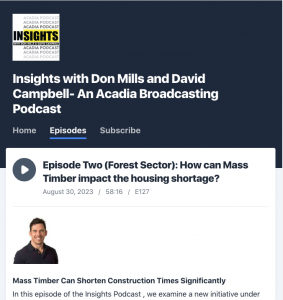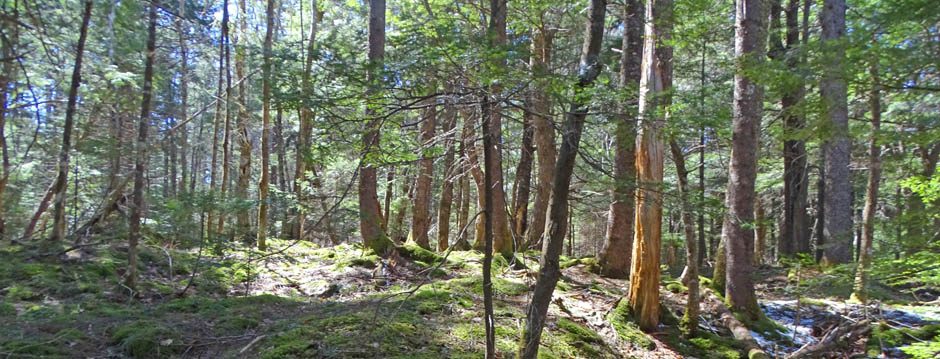‘Hard to find references to Mass Timber in NS; it is surely known to sawmill operators and other industry players in NS. There is ‘a plan’ for its rollout in NS, led by a few individuals and enterprises in the private sector; the extent of government involvement is difficult to discern.
“Mass Timber” is not mentioned in the two volumes of the Lahey report (2018).
On novasoctia.ca, one item is cited in a search for “Mass Timber”: Forestry Innovation Transition Trust Approves Four More Projects (Economic Development
July 20, 2022).
MTC Mass Timber Company Inc. will receive $325,000 for feasibility testing for commercial production of mass timber in the province.
I recently inquired about the state of this report:
To: Forestry Innovation Transition Trust <FITT@novascotia.ca> Dec 12, 2023: Can you tell me anything about the ‘feasibility testing for commercial production of mass timber in the province’ re: press release July 20, 2022. https://novascotia.ca/news/release/?id=20220720001
Response, Dec 13, 2023, from Mike Queripel, CPA, CMA, Project Executive, Department of Economic Development, 1809 Barrington Street (CIBC Building), Suite M103: “The funding you referenced was provided to MTC Mass Timber Company Incorporated which is a Nova Scotia based company exploring options for establishing mass timber manufacturing in the province. The project will test the strength profile, moisture content and moulding abilities of provincial feedstocks. The study is not yet complete, but we generally ensure studies funded through the trust are publicly available. Happy to share this when its available.”
 With some searching, I located this podcast interview with Patrick Cobbe, the founder & president of MTC Mass Timber Company Inc: How can Mass Tiber impact the Housing Shortage
With some searching, I located this podcast interview with Patrick Cobbe, the founder & president of MTC Mass Timber Company Inc: How can Mass Tiber impact the Housing Shortage
Dated Aug 30, 2023, the 58 minute interview is listed on the Acadia Podcast Insight Series with Don Mills and David Campbell
This podcast combines the experiences of an economist, David Campbell and a social scientist, Don Mills, to explore the challenges and opportunities facing Atlantic Canada, to promote data-driven decision making among policymakers and to encourage a wider dialogue and debate leading to greater prosperity for the region. Expect to hear interviews with the top influencers, business leaders and decision-makers across Atlantic Canada to inform, educate and expand the conversations on the key issues facing the region.
It’s a wide-ranging, highly informative interview, and provides a good intro. to use of Mass Timber generally, the state of the industry in Canada, and Cobbe’s vision of how he sees technology unfolding in NS. It is a purely architecture/sawmill/construction industry perspective; there is no mention by Cobbe or the interviewers of issues related to sustainability of wood production in NS, forest conservation etc. Regardless, given the difficulty of trying to find out more about possible plans for Mass Timber in NS (re my inquiry cited above), it was refreshing to read it. Cobbe is obviously very well qualified and makes a very good case for Mass Timber and what it has to offer us, at least from a construction perspective. As well, he shares some insights into the bureaucratic processes which otherwise are hard to come by. Thx, Peter Cobbe, David Campbell and Don Mills.
On Nova Scotia Forest Notes (2016), there is a page on Wood construction with many items relating to Mass Timber over period 2017-2022)
(This page is the 3rd cited item in a Google search for “Mass Timber” “Nova Scotia”)
More from Google Search
Bird Construction: Mass Timber
“Bird is a North American leader in wood construction with un-matched expertise, experience, and supply chain knowledge. We are investing in low-carbon building solutions to reduce the environmental impact of the construction industry. Under “Explore Our Mass Timber Projects”, they list East Hants Aquatic Centre
“Bird’s Mass Timber expertise, industry connections, and skilled self-perform labour force enabled the development of a sustainable and long-lasting solution for an iconic public building. CLIENT The Municipality of the District of East Hants CONSULTANT TEAL Architects CONTRACT TYPE Stipulated Sum PROJECT VALUE $15,000,000 PROJECT SIZE 2,700 sq. m (29,063 sq. ft) DURATION Undisclosed..Bird, the ownership team, and the design team, were all committed to using local resources wherever possible. For example, the wood for the showcase 1,500-square-metre Nailed Laminated Timber (NLT) roof over the natatorium was harvested within 10 kilometres of the local sawmill. Bird’s self-perform team manufactured the Nailed Laminated Timber panels straight from the sawmill planers and installed the roof. The wood will perform very well in the aquatic environment due to its hydroscopic properties – it naturally takes on and gives off water to balance out with its surrounding environment and prevents water from condensing on its surface.”
From The State of Mass Timber in Canada 2021
Natural resources Canada, 2021
p12 In Nova Scotia, the Roger Bacon Bridge (by Wood Research and Development Canada) is the longest clear-span, three-lane timber bridge in Canada. It was built in 2019 on existing timber piles that are expected to last another 100 years. By replacing the old steel bridge with mass timber, two-thirds of its weight was reduced, and the new bridge now has an impressive 62.5-tonne carrying capacity.
Why Canada is incentivizing mass timber development
On www.jll.ca/ December 03, 2019
Canada’s environmental agency, Natural Resources Canada (NRCan), has been funding the development of the mass timber industry through various programs since 2007. These efforts began with programs to support research and development of new materials, and in 2013 the agency also began funding commercial-scale projects through the Tall Wood Building Demonstration Initiative – which helped support construction of the 18-story Brock Commons.
Building on this success, in 2017 the government launched the more ambitious Green Construction through Wood program, known as GCWood. The program held a series of solicitations for nearly $40 million in funding to cover the incremental costs of many more demonstration projects, including 77 Wade, with separate funding rounds for tall wood buildings (i.e. taller than 10 stories), low-rise non-residential buildings, and timber bridges.
Federal and state governments have also worked to reduce regulatory barriers to mass timber. Included in NRCan’s research program was funding for work by scientific experts and regulatory agencies to develop regulations allowing wood frame construction up to 6 stories in the 2015 National Building Code of Canada (NBC). British Columbia, Quebec, Ontario, Alberta, and Nova Scotia all subsequently adopted these regulations in their provincial building codes.
These code changes rival NRCan’s grants as factors in catalyzing Canada’s wood construction boom.
Spiked Together: Nail-laminated timber – a good way to incorporate wood in public buildings
In Atlantic Forestry Review Jan 2019, pp32-33 “Green construction advocates get pretty excited about high-tech engineered wood products like cross-laminated timber(CLT), but at this point such products are specialtymaterials that are hard to spec into a project, due to the absence of local expertise and production capacity. There is, however, another approach to mass timber construction that can be adopted much more easily. Nail-laminated timber (NLT) has actually been around forever – or at least since mass-produced nails and lumber became readily available – and with the recent push toward wood construction as a means of carbon sequestration, it is regaining favour. One example is the new East Hants Aquatic Centre, a $19 million project currently under construction in Elmsdale,
